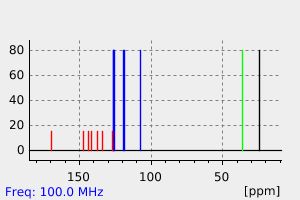3-羟基-2-乙酰氨基芴 | 1838-56-8
中文名称
3-羟基-2-乙酰氨基芴
中文别名
——
英文名称
3-Hydroxy-2-acetamidofluorene
英文别名
3-Hydroxy-2-(acetylamino)fluorene;3-hydroxy-2-acetylaminofluorene;N-(3-hydroxy-fluoren-2-yl)-acetamide;N-(3-Hydroxy-fluoren-2-yl)-acetamid;2-Acetylamino-fluoren-3-ol;3-hydroxy-2-acetamido-fluorene;N-(3-Hydroxy-2-fluorenyl)acetamide;N-(3-hydroxy-9H-fluoren-2-yl)acetamide
CAS
1838-56-8
化学式
C15H13NO2
mdl
——
分子量
239.274
InChiKey
MNPABTKJCQDDNY-UHFFFAOYSA-N
BEILSTEIN
——
EINECS
——
-
物化性质
-
计算性质
-
ADMET
-
安全信息
-
SDS
-
制备方法与用途
-
上下游信息
-
文献信息
-
表征谱图
-
同类化合物
-
相关功能分类
-
相关结构分类
物化性质
-
熔点:237-238 °C(Solv: acetic acid (64-19-7))
-
沸点:381.93°C (rough estimate)
-
密度:1.1198 (rough estimate)
计算性质
-
辛醇/水分配系数(LogP):2.4
-
重原子数:18
-
可旋转键数:1
-
环数:3.0
-
sp3杂化的碳原子比例:0.13
-
拓扑面积:49.3
-
氢给体数:2
-
氢受体数:2
安全信息
-
海关编码:2924299090
SDS
上下游信息
-
下游产品
中文名称 英文名称 CAS号 化学式 分子量 —— 3-Methoxy-2-(acetylamino)fluorene 6893-21-6 C16H15NO2 253.301
反应信息
-
作为反应物:描述:参考文献:名称:Nucleophilic aromatic substitution on ester derivatives of carcinogenic N-arylhydroxamic acids by aniline and N,N-dimethylaniline摘要:Decomposition of N-(pivaloyloxy)-2-(acetylamino)fluorene (1b) and N-(sulfonatooxy)-4-(acetylamino)-biphenyl (2a) in MeOH occurs predominately via N-0 bond cleavage to yield oxazoles (5, 6, 23), methoxy adducts (7,8,24,25,26), and rearrangement products (10b,11b,28). Minor ester methanolysis paths lead to the N-arylhydroxamic acids (9, 27). In the presence of 0.1 M aniline (3), 1b yields a number of adducts (14-18) identical to those previously obtained from the reaction of 3 with N-(sulfonatooxy)-2-(acetylamino)fluorene (1a). This occurs with no change in the rate constant for decomposition of 1b. At 0.1 M 3 all solvolysis products of 1b, except the rearrangement products 10 band 11b, are reduced below detectable levels. Similar results were obtained for 2a, which yields the adducts 30-35 in the presence of 3 and 36-38 in the presence of N,N-dimethylaniline (4). These results are consistent with a mechanism (Scheme V) in which the N-O bond heterolysis leads to a tight ion pair that can undergo internal return to yield the rearrangement products or diffusional separation to yield the free ion. The free nitrenium ion can be trapped by solvent or added nucleophiles. Both the N-acetyl-N-(4-biphenylyl)nitrenium ion (45) and the N-acetyl-N-(2-fluorenyl)nitrenium ion (48) react slowly enough with the solvent to undergo selective reaction with strong nucleophiles. Since 1a, 1b, and 2a span the reactivity range of the ester derivatives of the common N-arylhydroxamic acids which undergo N-O bond heterolysis in H2O, it appears that all of the carcinogenic esters will react with simple aromatic amines via an S(N)1 mechanism.DOI:10.1021/jo00079a028
-
作为产物:描述:参考文献:名称:致癌物的Omicron-甲氧基衍生物N-2-芴基乙酰胺。潜在的潜在生物芳构剂。摘要:DOI:10.1021/jm00323a018
文献信息
-
Nucleophilic substitution on the ultimate hepatacarcinogen N-(sulfonatooxy)-2-(acetylamino)fluorene by aromatic amines作者:Michael Novak、Kanchugarakoppal S. RangappaDOI:10.1021/jo00030a043日期:1992.2The kinetics and products of the reactions of the title compound 1 with aniline (5) and N,N-dimethylaniline (6) were investigated in MeOH. Addition of 5 (0.1-0.4 M) to a solution of 1 in MeOD-d4 has no effect on the overall rate of decomposition of 1 but generates a number of adducts (20-24) in moderate to high yield. The yields of all solvolysis products, except the rearranged O-sulfates 18 and 19, are suppressed by the addition of 5. The kinetic and product data are consistent with an S(N)1 mechanism (Scheme IV) in which 18 and 19 are generated by internal return from a tight ion pair, but all other products are generated by nucleophilic attack on a free nitrenium ion or solvent separated ion pair. The reaction of 6 with 1 shows similar characteristics to that of 5 with the exception that 6 reduces 1 in moderate yield to generate 2-(acetylamino)fluorene (25). This reduction occurs in competition with reaction to generate adducts (26, 27) similar to those obtained with 5. Kinetic and product data indicate that 25 is generated by reaction of 6 with a nitrenium ion intermediate. The differences in the behavior of 5 and 6 may be explained by cyclic voltammetry results which show that 6 is oxidized in MeOH more readily than 5 by about 2.5 kcal/mol. The reaction of 1 with 5 and 6 is considerably different from the reactions of the same amines with the N-aryl-O-pivaloylhydroxylamines, which were previously shown to proceed via an S(N)2 mechanism. This change in mechanism may be attributed, in part, to increased steric hindrance at the nitrogen of 1 due to the N-acetyl group.
-
Novak Michael, Rangappa Kanchugarakoppal, Manitsas Rebecca K., J. Org. Chem, 58 (1993) N 27, S 7813- 7821作者:Novak Michael, Rangappa Kanchugarakoppal, Manitsas Rebecca K.DOI:——日期:——
表征谱图
-
氢谱1HNMR
-
质谱MS
-
碳谱13CNMR
-
红外IR
-
拉曼Raman
-
峰位数据
-
峰位匹配
-
表征信息
同类化合物
(S)-2-N-Fmoc-氨基甲基吡咯烷盐酸盐
(2S,4S)-Fmoc-4-三氟甲基吡咯烷-2-羧酸
黎芦碱
鳥胺酸
魏因勒卜链接剂
雷迪帕韦二丙酮合物
雷迪帕韦中间体6
雷迪帕韦
雷迪帕维中间体
雷迪帕维中间体
雷尼托林
锰(2+)二{[乙酰基(9H-芴-2-基)氨基]氧烷负离子}
醋酸丁酸纤维素
达托霉素杂质
赖氨酸杂质4
试剂9,9-Dioctyl-9H-fluoren-2-amine
螺[环戊烷-1,9'-芴]
螺[环庚烷-1,9'-芴]
螺[环己烷-1,9'-芴]
螺[3.3]庚烷-2,6-二-(2',2'',7',7''-四碘螺芴)
螺-(金刚烷-2,9'-芴)
螺(环己烷-1,9'-芴)-3-酮
藜芦托素
荧蒽 反式-2,3-二氢二醇
草甘膦-FMOC
英地卡胺
苯芴醇杂质A
苯甲酸-(芴-9-基-苯基-甲基酯)
苯甲酸-(9-苯基-芴-9-基酯)
苯并[b]芴铯盐
苯并[a]芴酮
苯基芴胺
苯基(9-苯基-9-芴基)甲醇
苯(甲)醛,9H-芴-9-亚基腙
苯(甲)醛,4-羟基-3-甲氧基-,(3-甲基-9H-茚并[2,1-c]吡啶-9-亚基)腙
芴甲氧羰酰胺
芴甲氧羰酰基高苯丙氨酸
芴甲氧羰酰基肌氨酸
芴甲氧羰酰基环己基甘氨酸
芴甲氧羰酰基正亮氨酸
芴甲氧羰酰基D-环己基甘氨酸
芴甲氧羰酰基D-Β环己基丙氨酸
芴甲氧羰酰基-O-三苯甲基丝氨酸
芴甲氧羰酰基-D-正亮氨酸
芴甲氧羰酰基-6-氨基己酸
芴甲氧羰基-高丝氨酸内酯
芴甲氧羰基-缬氨酸-1-13C
芴甲氧羰基-叔丁基二甲基硅-D-丝氨酸
芴甲氧羰基-beta-赖氨酰酸(叔丁氧羰基)
芴甲氧羰基-S-叔丁基-L-半胱氨酸五氟苯基脂







